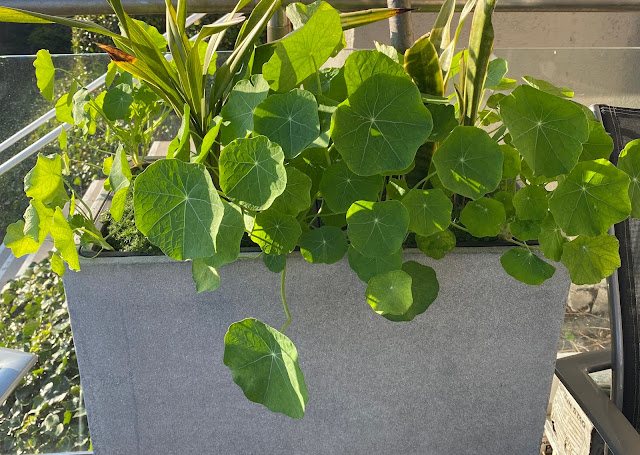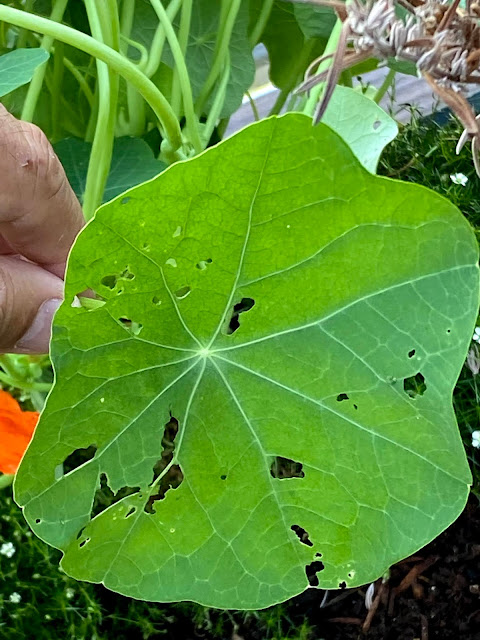Figure #1 July 29, 2020
How to get started. 1. Walk around your neighborhood looking for Nasturtiums [Figure 2a]. Then check for seeds. [Figure 2b]. Order nasturtiums on line if you don’t spot any in your neighborhood (see seed package in Figure 2d.
Figure #2a from seeds planted June 2020 showing natural growth as compared to “waterfall guided” growth below.
Figure #2b “Flowers-In-A-Waterfall” guided nasturtium from a seed planted July 9, 2021. This photo, October 1, 2021 shows eleven weeks of growth.
How to create a “Flowers-In-A-Waterfall” effect with nasturtiums.
Figure #2c: Second Generation Nasturtium seeds [Blue arrows] developing on a First Generation nasturtium germinated in June 2020,
elasped time: 2.5 months.]
Figure 2d: Or check online. This package is enough to start your whole class or neighborhood on scientific experiments with thousands of possibilities. Seeds from this package are labeled First Generation seeds.
Figure #3
Let me know if your package actually contains the stated number of seeds.
[See the journal entries below.] It’s important to follow the germination instructions on back of the package. If not, germination will take longer.
- July 16, 2020 Planted 12 scarified [scratched] Nasturtium seeds to germinate.
- July 20, four seeds have sprouted
- July 24, observed 4 sprouts each 1.5 inches tall
- July 29 Transplanted one of these [now 5 inches tall] to glass sphere [see Figure #1 above.]
- August 1, introduced Irish Moss into the experiment, but might get better nasturtium results without the moss competing for water and nutrients. But who knows, there might be a symbiotic relationship between the moss and nasturtiums. Let me know if you experiment with containers with and without moss. Should be interesting if all the experimental conditions are identical.
Figure #4
- Aug 7, Observed tiny eggs on three leaves. [Figure #6]
Aug 15, White butterfly closeup video
- Aug 16. Hypothesis 1: Nasturtiums have a biochemical to suppress larval infestations.
- Hypothesis 2: Nasturtiums can grow new leaves faster than white butterfly larva can consume leaves.
Lunch time at Nasturtium Cafe
- First observation of two white butterfly larvae. Third larva observed when second photo was posted.
-
- Aug 14, observed increasing leaf damage from grazing white butterfly larvae seen on leaves below. I’m beginning to wonder if this plant will survive, so I’ve relocated feeding larvae to other plants.
- Aug 16. Hypothesis 1: Nasturtium seedlings have a biochemical to suppress larval infestations.
- Hypothesis 2: Nasturtium seedlings can grow new leaves faster than white butterfly larva can consume leaves.
This nasturtium shows that hypothesis #1 may not have biochemicals to fend off white butterfly larvae. It also shows that hypothesis #2 is negative. Nasturtiums may not grow new leaves fast enough to survive white butterfly larval infestations, though it may be true that mature Nasturtiums might survive these infestations.
August 21, 2020 found this larva in the sphere. Two full length yellow body stripes [protective coloration?].
Discovery: There are two species of white butterfly: the small white [Pieris rapae] with velvet green larvae, and the large white butterfly [Pieris brassicae] black larvae with yellow stripes.
August 25, 2020 Fourth day for yellow striped larva. How many days until it pupates?
Saturday, August 29, 2020 The larva shown in the video clip above, drops to the potting soil [see arrow below], digs a vertical shaft approximately 1 inch deep, climbs in, turns around and caps the shaft. See photos below.
Shaft topped by a 9mm cap [see white circle below].
Diagram of underground shaft containing larva ready to pupate.
What happens next?
Larva stores energy then begins metamorphosis by building a pupal casing.
Filmed at The Monarch Lab, University of Minnesota.
Filmed at The Monarch Lab, University of Minnesota.



















